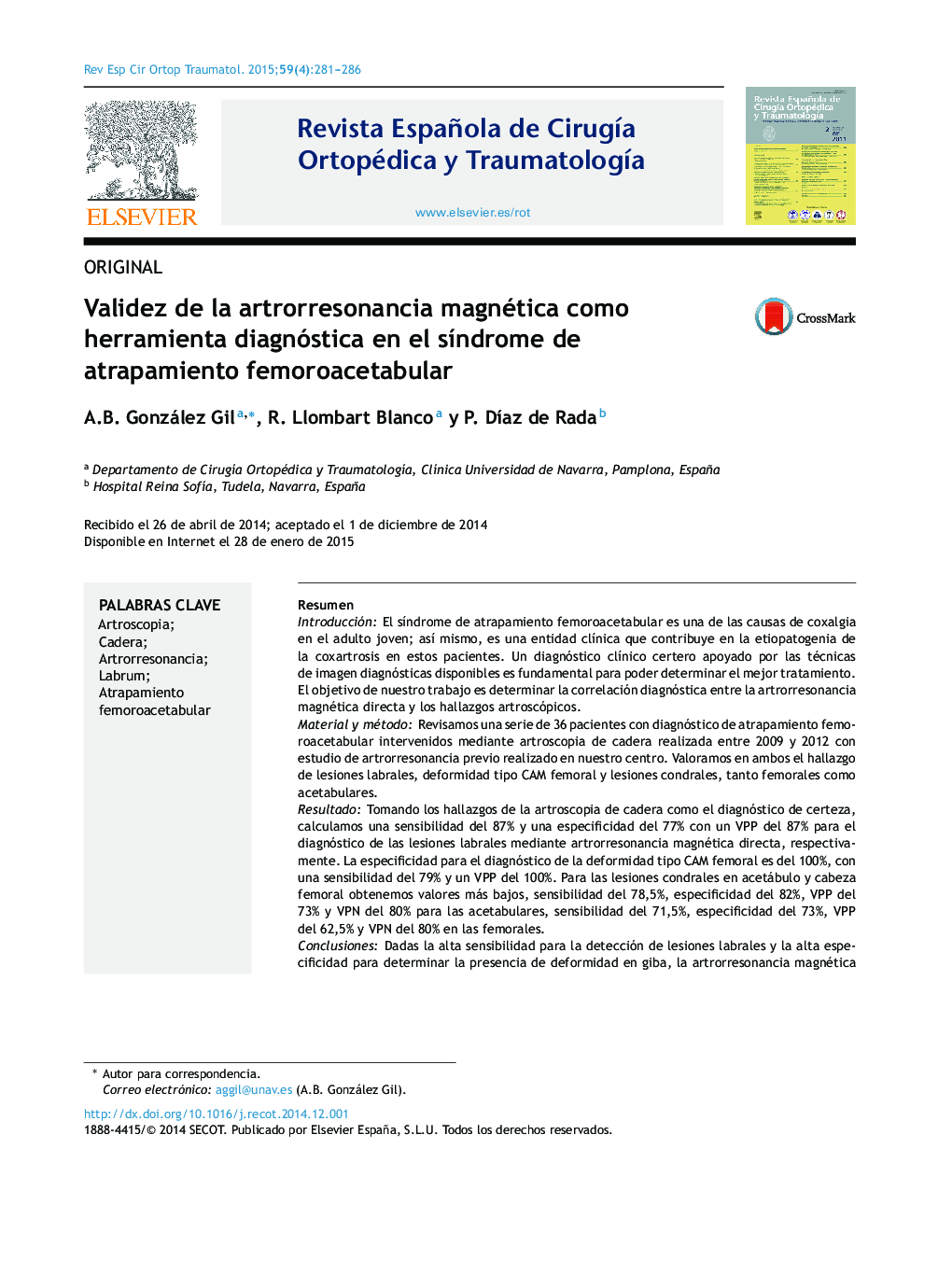| کد مقاله | کد نشریه | سال انتشار | مقاله انگلیسی | نسخه تمام متن |
|---|---|---|---|---|
| 4086204 | 1267936 | 2015 | 6 صفحه PDF | دانلود رایگان |

ResumenIntroducciónEl síndrome de atrapamiento femoroacetabular es una de las causas de coxalgia en el adulto joven; así mismo, es una entidad clínica que contribuye en la etiopatogenia de la coxartrosis en estos pacientes. Un diagnóstico clínico certero apoyado por las técnicas de imagen diagnósticas disponibles es fundamental para poder determinar el mejor tratamiento. El objetivo de nuestro trabajo es determinar la correlación diagnóstica entre la artrorresonancia magnética directa y los hallazgos artroscópicos.Material y métodoRevisamos una serie de 36 pacientes con diagnóstico de atrapamiento femoroacetabular intervenidos mediante artroscopia de cadera realizada entre 2009 y 2012 con estudio de artrorresonancia previo realizado en nuestro centro. Valoramos en ambos el hallazgo de lesiones labrales, deformidad tipo CAM femoral y lesiones condrales, tanto femorales como acetabulares.ResultadoTomando los hallazgos de la artroscopia de cadera como el diagnóstico de certeza, calculamos una sensibilidad del 87% y una especificidad del 77% con un VPP del 87% para el diagnóstico de las lesiones labrales mediante artrorresonancia magnética directa, respectivamente. La especificidad para el diagnóstico de la deformidad tipo CAM femoral es del 100%, con una sensibilidad del 79% y un VPP del 100%. Para las lesiones condrales en acetábulo y cabeza femoral obtenemos valores más bajos, sensibilidad del 78,5%, especificidad del 82%, VPP del 73% y VPN del 80% para las acetabulares, sensibilidad del 71,5%, especificidad del 73%, VPP del 62,5% y VPN del 80% en las femorales.ConclusionesDadas la alta sensibilidad para la detección de lesiones labrales y la alta especificidad para determinar la presencia de deformidad en giba, la artrorresonancia magnética directa de cadera supone una buena herramienta diagnóstica en el atrapamiento femoroacetabular.
IntroductionFemoroacetabular impingement (FAI) is one of the main causes of hip pain in young adult and a contributory factor for development of early primary osteoarthritis. An accurate clinical diagnosis, supported by imaging studies, is important to determine the best treatment for the patient. The aim of this study is to determine the diagnostic correlation between direct magnetic resonance imaging (MRI) arthrography and the arthroscopic findings.Materials and methodA review was performed on a series of 36 patients diagnosed with FAI, and who underwent hip arthroscopy surgery between 2009 and 2012. All of them had a direct MRI arthrography performed in our hospital. The presence of labral lesions, CAM deformity, and acetabular and femoral cartilage damage, were evaluated in both imaging techniques.ResultAfter analysing the results and taking the hip arthroscopy as ‘gold standard’, a sensitivity of 87% and a specificity of 77% were obtained, with a PPV of 87% for the diagnosis of labral lesions by direct MR arthrography. The specificity for CAM deformity was 100%, with a sensitivity of 79% and PPV of 100%. For chondral disorders lower values were found for both acetabulum and femoral head. For acetabular lesions the sensitivity was 78.5%, and specificity was 82% with a PPV of 73% and NPV of 80%. For femoral lesions, there was a sensitivity of 71.5%, a specificity of 73%, with a PPV of 62.5% and NPV of 80%.ConclusionsDue to the high sensitivity for the detection of labral lesions and the high specificity to detect CAM deformity, hip MR arthrography is a useful diagnostic tool for femoroacetabular impingement.
Journal: Revista Española de Cirugía Ortopédica y Traumatología - Volume 59, Issue 4, July–August 2015, Pages 281–286